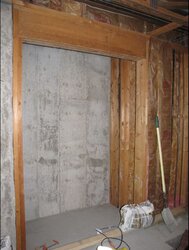Hello. First of all, this is a very informative forum. It was one of my best resources when I was deciding which pellet stove to purchase. I ultimately decided upon an Enviro Omega. This will be installed in a finished basement. Now to my question.
When I originally built the house, I had planned to put a zero clearance wood burning fireplace in the basement, so the alcove for the fireplace has an 8" metal chimney pipe in place already. I went to a local fireplace shop, and was adviced that I would need to run a 4" pellet stove pipe up through the 8" pipe at a cost of $2000 (this is about a 20' run from the basement, but that still sounds excessive). I then asked them about the frsh air intake and was told they are not necessary. So, I'm not sure I'm getting very good advice there. I definitely plan to install a 3" intake, running basically stright out the wall (I should add that this is a walkout basement, so that is fairly easy). My question is, is there any reason I need to run the 4"exhaust straight out the wall, when there is a 8" chimney running straight up? I know Duravent makes a 4" to 8" adapter. Has anyone else done this? Did you have adequate draft? Is there any other reason going straight out the wall would be adviseable over going up the existing chmney with the adapter? Thanks for any advice you can offer.
Kevin
When I originally built the house, I had planned to put a zero clearance wood burning fireplace in the basement, so the alcove for the fireplace has an 8" metal chimney pipe in place already. I went to a local fireplace shop, and was adviced that I would need to run a 4" pellet stove pipe up through the 8" pipe at a cost of $2000 (this is about a 20' run from the basement, but that still sounds excessive). I then asked them about the frsh air intake and was told they are not necessary. So, I'm not sure I'm getting very good advice there. I definitely plan to install a 3" intake, running basically stright out the wall (I should add that this is a walkout basement, so that is fairly easy). My question is, is there any reason I need to run the 4"exhaust straight out the wall, when there is a 8" chimney running straight up? I know Duravent makes a 4" to 8" adapter. Has anyone else done this? Did you have adequate draft? Is there any other reason going straight out the wall would be adviseable over going up the existing chmney with the adapter? Thanks for any advice you can offer.
Kevin


